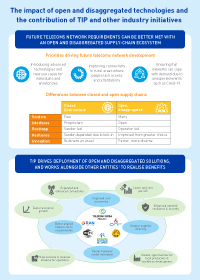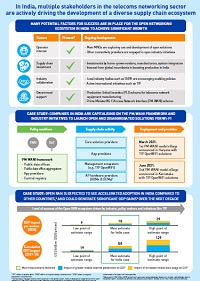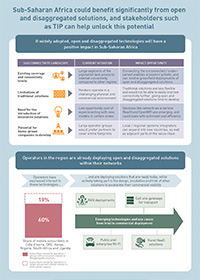The economic impact of open and disaggregated technologies and the role of TIP
10 November 2021 | Consulting
David Abecassis | Michael Kende | Shahan Osman | Caroline Gabriel | Rohan Dhamija | Ashwinder Sethi | Johann Adjovi
Report
Listen to or download the associated podcast
Since the start of the Covid-19 pandemic, it has become clear just how vital the telecoms industry has become to the functioning of our societies. From Oslo to Santiago, San Francisco to Manila, every person with the means to connect to the internet now relies heavily on the fibre, copper and radio networks that carry work, social, leisure and other vital information.
In advanced economies, mobile operators are on the cusp of introducing 5G, but face the challenge of justifying large investments, particularly in the radio network, with an unproven business case and uncertain demand. In emerging markets, many people still cannot access, or afford, mobile broadband. Meanwhile, operators’ margins are under pressure, due to commoditisation, competition and upwards pressure on investments brought about by explosive demand growth, an increased focus on security and resilience of networks, and tight and concentrated equipment supply chains.
Improved network cost efficiency is key to making these investments possible, in particular through infrastructure sharing, carve-out of passive infrastructure1 and radio access network (RAN) sharing models, including innovations such as ‘network as a service’.
In this context, telecoms stakeholders are coming together in a number of industry initiatives to open up and standardise interfaces between different network components, which would allow solutions from different vendors to work together or ‘interoperate’. This would open up networks to new vendors, and would also allow ‘traditional’ vendors to continue innovating by focusing on areas where they have unparalleled expertise. The vision that stakeholders including the Telecom Infra Project (TIP) are promoting is one where vendors and operators come together to innovate and bring to market solutions that respond directly to operators’ requirements, in a quick and cost-effective manner.
We look forward to continuing to support stakeholders across the ecosystem to develop and execute strategies that will achieve the best possible outcome for the telecoms industry in these times of rapid change.
Findings from our global report (May 2021)
Analysys Mason looks at the economic impact of open and disaggregated networks, and we quantify what this impact could be on global GDP by focusing on Open RAN. Other initiatives we explore include Open Optical and Packet Transport (OOPT), and the recently launched OpenWiFi initiative. The impact of all of these technologies on networks globally could be transformational.
Standardised solutions, built by a range of suppliers based on industry requirements, could unlock greater cost efficiency and faster deployment of new network functions than proprietary solutions.
This new way of innovating around networks could enable faster and lower-cost greenfield deployment, in rural and hard-to-reach areas. It could also improve the time to market for new network functions in urban areas (e.g. smart-city use cases), and therefore accelerate testing of new business models, and therefore innovation.
Security and resilience are increasingly at the forefront of operators’ and policy makers’ thinking. There has been some debate about whether open and disaggregated networks would be better or worse than proprietary systems from this perspective, but the debate seems to have settled decisively in favour of the former. There are challenges to overcome, but it is clear that supplier diversity is key to the resilience and robustness of supply chains. Security risks are being mitigated through rigorous testing.
Our report finds that the economic benefits of a successful open and disaggregated network supply chain could be significant. More cost-effective RANs, built on the basis of operators’ requirements rather than vendors’ roadmaps, could lead to over USD285 billion in additional GDP globally over the next ten years, and over USD90 billion annually from 2030. This assumes that Open RAN will be deployed in about half the global footprint of mobile networks by 2030, with a total cost of ownership (TCO) benefit of 10–15%. This is conservative, and if Open RAN principles are adopted globally, benefits could triple.
How can the industry and policy makers support the development and deployment of open and disaggregated networks? We identified three main areas of focus, which will accelerate technology deployment and allow operators to have confidence in deploying disaggregated technologies at scale.
- First, an expansion of platforms for testing and integration of disaggregated solutions through more active collaboration between operators, vendors and systems integrators, together with support for full adherence to open standards and interoperability of solutions.
- Second, transparent product development and testing (e.g. through TIP Community Labs) with a clear focus on full interoperability, security and resilience; this will prevent inefficient duplication of efforts, avoid fragmentation of standards and ‘proprietary “creep”’, and allow networks to support mission-critical use cases.
- Finally, clear policy and fiscal support by governments and policy makers; supply chain strategies focused on resilience, security, vendor diversity, and accelerated network transformation are all fully aligned with the objectives of the open and disaggregated network movement.
We are already seeing momentum building in all these areas: five major European operators recently signed a memorandum of understanding to implement Open RAN,2,3 which sends a strong signal for vendors to accelerate investments; the UK government expressed explicit support for Open RAN adoption as part of its recently published vendor diversification strategy; and ecosystem organisations including TIP are continuing to play an active role in helping the industry on its way to commercialisation and deployment of open solutions at scale. Increased active participation of more vendors and operators in the open ecosystem will further accelerate the development of the multi-vendor supply chain, which will be crucial for maximising the potential benefits of open and disaggregated technologies.
Proactive involvement of policy makers will also be key to unlocking even larger economic benefits. Conversely, a lack of co-ordination on key issues (such as a lack of alignment on the adoption of open standards and refragmentation, resulting in implementations that are not interoperable), would result in a reduction in the potential for open and disaggregated technologies to generate the envisioned impact and to help achieve policy objectives.
Findings from our India (July 2021) and Sub-Saharan Africa (November 2021) reports
After publishing our initial global report in May 2021, we subsequently published a report in July 2021 looking specifically at developments in India, and another in November 2021 that focuses on Sub-Saharan Africa.
In India, mobile operators have been actively exploring the use of open and disaggregated technologies in their networks, and have also started to develop in-house solutions that can be exported globally (if and when proven) and scale beyond India to the world. The government of India is also taking steps to strengthen local manufacturing capabilities. This involves incentivising large global players to set up production facilities in India. More importantly in the context of open and disaggregated network technology, the government’s efforts also include supporting homegrown companies to develop solutions that could meet local demand for network equipment and software for years to come, while also exploiting opportunities in the global export market. The supply chain ecosystem in India, made up of original design manufacturers (ODMs), vendors and systems integrators, is also responding to growing demand and government-backed initiatives by developing new disaggregated solutions spanning various network parts and by continuing to foster relationships with international customers to capitalise on emerging export opportunities.
India is expected to be at the forefront of open and disaggregated technology adoption and production in years to come due to the amount of activity driven by its operators, the government and supply chain participants in developing open and disaggregated technologies. For Open RAN alone, we estimate that the incremental GDP impact in India could reach USD18 billion per annum in 2030 (USD58 billion cumulatively from 2021–30), driven by enhancements to mobile internet penetration and data usage. Modelling suggests that these impacts could more than double over the period from 2021–30, should industry facilitation initiatives driven by operators, the government, as well as organisations such as TIP be as successful as envisaged by many of the stakeholders driving Open RAN in India today.
Internet connectivity and digital infrastructure play a vital economic and social role globally, helping to deliver education, health care and other key services. Despite real progress in recent years, connectivity in sub-Saharan Africa (SSA) is beset by challenges, including barriers to the deployment of digital infrastructure. Much remains to be done to enable SSA to catch up with global connectivity. Expanding the delivery of accessible and affordable internet access requires a constant stream of innovation and efficiency gains in the global supply chain to drive improved performance, diversity and cost-effectiveness of network solutions.
African telecom companies are not short of ambition. In addition to continued investment and experimentation with innovative ways of deploying and operating networks, many operators across the region have also begun trials and/or commercial deployments of open and disaggregated solutions in their transport networks. These solutions include DCSG, one of the technologies incubated within the Telecom Infra Project (TIP). Several rural ‘network-as-a-service’ (NaaS) players have also entered multiple markets in the SSA region, adopting innovative business models and open networking principles to deliver mobile services in previously unconnected areas. Disaggregated solutions are also emerging in other areas, with the first commercial deployment of TIP OpenWiFi in the region having been announced in November 2021. Other niche opportunities such as indoor small cells and enterprise private networks could start to develop in the region, either offered by operators, or neutral host infrastructure providers.
Although many of these solutions still rely on the scale and know-how of global vendors, SSA-based companies are increasingly expanding beyond distribution, into the deployment and integration of open and disaggregated network systems, with an eye toward expanding their offerings as large scale and high impact technologies such as Open RAN mature further.
Modelling suggests that large scale deployment of Open RAN could have a positive impact on wider GDP growth in the region. We estimate that this could create an additional USD15 billion in annual GDP by 2030 (in real 2020 USD) and USD44 billion cumulatively from 2021 to 2030.
In the short term, several challenges such as difficult unit economics and operating conditions, operator use of legacy technologies, and reliance on incumbent vendors for systems integration, could make it difficult for operators to adopt Open RAN in the near future, although smaller or newer operators with fewer legacy network constraints could already start deploying these technologies. If these challenges are effectively addressed, then a faster and wider adoption of Open RAN could result in a cumulative GDP impact of USD135 billion by 2030, three times our baseline case estimate.
Going forward, the success of these technologies in SSA will depend both on the ability of the technology and vendors in the ecosystem to respond to the needs of African operators, including by driving efficiency and cost-effectiveness above current solutions. More broadly, support from policy makers, local and regional industry organisations, and financiers including development finance organisations, are all essential to the success of open and disaggregated technologies and their impact on connectivity and the broader economies of countries in the region.
For more information, please contact David Abecassis (Partner) or Caroline Gabriel (Research Director).
1 A passive infrastructure ‘carve-out’ in the mobile sector usually refers to a process where a mobile operator sells some or all of its towers to a third-party infrastructure provider, who then markets tenancies on these towers to all operators in the market, facilitating infrastructure sharing
3 See https://www.gruppotim.it/en/press-archive/corporate/2021/PR-TIM-ORAN-en.html
Infographics
The economic impact of open and disaggregated technologies and the role of TIP
Global India Sub-Saharan Africa
David Abecassis
Managing Partner, expert in strategy, regulation and policy
Michael Kende
Senior Adviser
Shahan Osman
Manager
Caroline Gabriel
Partner, expert in network and cloud strategies and architecture
Rohan Dhamija
Managing Partner | Director Head - Middle East and India (South Asia)
Ashwinder Sethi
Partner



